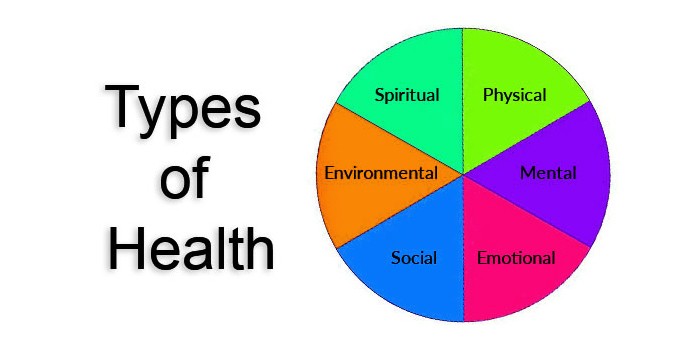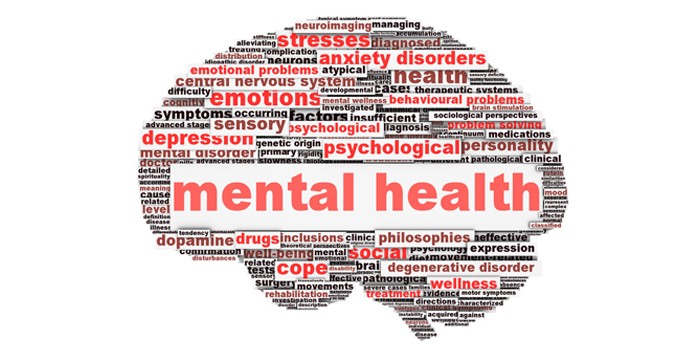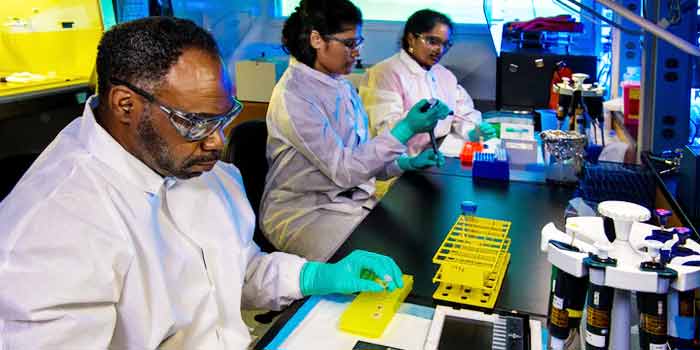Book: Health and Fitness
Author: Nayma Nishat - Researcher, Health & Fitness

After going through my last two writings, What is Health and its History, my dear friends let’s move to the Different Types of Health. When we talk about health, it is common for many people to think about physical health, in itself a person suffers or does not suffer from an illness. However, the concept of health is much broader and covers other areas of our life.
Some experts consider that health can only be talked about when the body is in optimal conditions anatomical and physiological. While others state that it is a factor or a range to determine if the body functions in its normal or at least acceptable conditions, in such a way that, from this perspective, health is seen as a margin of determination.
There are different definitions of this concept, but one of the most successful is that of the WHO, which was made public in the Preamble to the Constitution of the World Health Organization, which was approved at the International Sanitary Conference, held in New York in the year 1946. This definition, which has not changed since then, affirms that health is “a state of complete well-being, physical, mental and social.”
There are mainly six different types of Health includes Physical health, Mental health, Emotional health, Social health, Environmental health, and Spiritual health.
The detailed explanation of these six different types of health is given below.
Physical health refers to the state of your physical body and how well it is operating. It is influenced by levels of physical activity, adequate nutrition, rest, environments, etc.

Physical health promotes proper care of our bodies for optimal health and functioning. Obtaining an optimal level of physical wellness allows you to nurture personal responsibility for your own health. As you become conscious of your physical health, you are able to identify elements you are successful in as well as elements you would like to improve.[1]
Physical health consists of many components, but a brief list of the key areas are given below:
Mental health is a level of psychological well-being or an absence of mental illness. It is the “psychological state of someone who is functioning at a satisfactory level of emotional and behavioral adjustment”.[3]

Good mental health doesn’t just mean if you don’t have a mental illness. It’s about having a sense of purpose, getting involved with things, coping with stress and setbacks, forming close relationships, and being in touch with your own thoughts and emotions. To maintain mental health we have to be confident and accept ourselves. In this case, yoga and breathing exercises help us to focus and keep negative thoughts out of our minds.
Emotional health refers to a person’s feelings which encompasses everything about you. It actually governs all of your decisions, your mood, and who you are. Every single aspect of you is determinant of how you feel about something, what is actually going on in your heart, not in your head.

Basically, from your relationships to your mindset to your personality, to how you want to show up in the world; all of these are run by your emotional health. And if you’re feeling thoughts of overwhelm, anxiety, stress, worthlessness, these are all common negative emotions that can have a hugely detrimental effect on your emotional health. But if you can rightly understand yourself, and find out from where these negative emotions are coming, then you actually be setting yourself up for a lifetime of consistent success.
Social health is how you get along with other people, which involves your ability to form satisfying interpersonal relationships with others. It also relates to your ability to adapt comfortably to different social situations and act appropriately in a variety of settings.[4]

If you want to really optimize your health, you need to go beyond physical and mental strength and actually look at the strength of your close social relationships. Research now shows that a lack of strong social ties puts you at a greater health risk than obesity.
If we really want to understand human thriving, the social component is essential. There is 80 years long Harvard study done on individuals that showed the quality of close social relationships was actually the best victor of health and happiness. So not only it’s important to consider the health of our bodies but we need to consider the health of our communities.
Environmental Health is the field of science that studies how the environment influences human health and disease. “Environment,” in this context, means things in the natural environment like air, water, and soil, and also all the physical, chemical, biological, and social features of our surroundings.

According to the National Institute of Environmental Health Science, The social environment encompasses lifestyle factors like diet and exercise, socioeconomic status, and other societal influences that may affect health.[5]
We need to be aware of the impact of changing the environment of our health, how it can be influenced, and what can cause the complex diseases such as cancer, cardiovascular disease, metabolic syndrome within malaria, TV, AIDS, etc. and how our environment influenced to contract these diseases.
Spiritual health refers to possessing, meaning, and purpose in life; having a clear set of beliefs and living in accordance with your morals, values, and ethics. Essentially it means understanding and having a clear definition of what is right and wrong and living according to this understanding.

The National Wellness Institute says spiritual wellness follows the following tenets:
Many factors play a part in defining spirituality – religious faith, beliefs, values, ethics, principles, and morals. Some gain spirituality by growing in their personal relationships with others, or through being at peace with nature. Spirituality allows us to find the inner calm and peace needed to get through whatever life brings, no matter what one’s beliefs are or where they may be on your spiritual journey.
The human spirit is the most neglected aspect of our selves. Just as we exercise to condition our bodies, a healthy spirit is nurtured by purposeful practice. The spirit is the aspect of ourselves that can carry us through anything. If we take care of our spirit, we will be able to experience a sense of peace and purpose even when life deals us a severe blow. A strong spirit helps us to survive and thrive with grace, even in the face of difficulty.[6]
We should take care of our spirit to experience a sense of peace and purpose even when life deals with some difficulty. A strong spirit only helps us to survive and thrive with grace.
In addition to the types of health mentioned in the previous lines, and which are part of the WHO definition, there are also 4 different types of Health, such as Family Health, Sexual Health and Reproductive Health, Occupational Health, and Public Health.
Let’s see the details below.
Family health is a working instrument, with a comprehensive approach, on promotion and prevention, to train the entire health team that intervenes in families with difficulties of various kinds: risk factors, crises, and conflicts.

Human beings acquire many habits in the family that largely determine our health, and therefore our well-being. Therefore, it is very important that, in addition to taking care of yourself by applying all the measures that, you also take care of the little ones, instilling healthy habits in them that will help them have a better quality of life.
Besides, you must know the specific indications, as well as the medical check-ups that should be carried out based on age, sex, or in specific periods such as pregnancy.
Please remember, good family health positively affects its members.
Sexual health is defined by the World Health Organization (WHO) as “a state of physical, emotional, mental and social well-being related to sexuality; it is not just the absence of disease, dysfunction or disability. For sexual health to be achieved and maintained, the sexual rights of all people must be respected, protected, and fully exercised”.

For its part, the Pan American Health Organization (PAHO) has defined sexual health as “the experience of the permanent process of achieving physical, psychological, and sociocultural well-being related to sexuality.”
Sexuality is a central aspect of the human being throughout his life and includes sex, gender identities, and roles, sexual orientation or preference, eroticism, pleasure, intimacy, and reproduction.
Sexual and reproductive health is the ability to enjoy a satisfying sex life without the risk of childbearing, and the freedom to decide to do so or not to do so. Reproductive rights are based on the recognition of the basic right of all couples and individuals to freely and responsibly decide the number of children, the spacing of births and the interval between them, to have the information and the means to do so; and the right to achieve the highest level of sexual and reproductive health.
For this, 2 communication strategies and materials have been developed that will allow positioning the importance of sexual and reproductive health.
(I) Double Protection
It provides information on ways to protect yourself from a sexually transmitted disease including HIV / AIDS and at the same time avoid an unplanned pregnancy, without preventing full sexuality.
(II) Family Planning
It informs about methods and tools that allow planning the family and living an adequate sexual and reproductive health. Sexuality is a central aspect of the human being throughout his life. For sexual health to be achieved and maintained, the sexual rights of all people must be respected. Indeed, to achieve this, the WHO assures that a “positive and respectful approach to sexuality and sexual relations is required, as well as the possibility of having pleasant and safe sexual relations, free from coercion, discrimination, and violence.”[7]
The occupational health is a multidisciplinary entity that is focused on achieving the most complete state of physical, mental, and social workers in performing work.

The occupational health encompasses various areas, focusing mainly on prevention and control of occupational hazards, reduce diseases and accidents associated with any job, aspects that more and more people are aware of its importance.
An example is the growing interest of company leaders in strengthening a corporate culture focused on improving occupational health through the creation of healthy workspaces.
According to figures from the International Labor Organization (ILO), approximately more than 2 million people die each year from diseases and accidents at work.
In addition, more than 200 million cases of professional ailments are registered per year. Likewise, non-communicable diseases in the office also directly or indirectly cause each country to lose up to 6% of its GDP. That is why occupational health should be a priority and an aspect that all companies and the State must guarantee.
Therefore, we could say that occupational health is the “set of activities whose objective is the promotion and maintenance of the highest possible degree of physical, mental and social well-being of workers, promoting the adaptation of work to the person and the person at your work”.
The public health is a non – clinical specialty-focused medicine in the promotion, prevention, and intervention of health from a multidisciplinary and collective perspective, whether at the community, regional, national or international level, i.e., not centered on the individual, but in the collective.

In this sense, its functions are mainly the management, surveillance, and improvement of the health level in the population, as well as the prevention, control, and eradication of diseases.
In addition, it is responsible for developing public policies, guaranteeing access, and the right to the health system, creating educational programs, administration of services, and research. Even tasks related to environmental sanitation, food quality control, among other things, maybe part of their competencies.
Due to the breadth of its functions, multiple disciplines oriented to the administration of the health system converge in public health, such as medicine, pharmacy, veterinary medicine, nursing, biology, pedagogy, social and behavioral psychology, work social, sociology, statistics, etc.
The public health can be administered by an organized community, by a government agency, or an international one. Normally, each country has its corresponding Ministry of Health or Secretariat of Health, which is the State agency responsible for ensuring the health conditions of the population.
Similarly, there are international organizations, such as the Pan American Health Organization (PAHO) or the World Health Organization (WHO), created to manage prevention and health care policies at supranational levels.
We all have the right to understand our health. We are often intimidated, embarrassed, and afraid when we are patient. But from this writing, I wanted to equip and inform all of you so that we regain control over our body, health, and well-being.
From the overall discussion, we can understand, without knowledge concerning health, and the types of health, it will be difficult for us to find out who we are, what our health condition is, and what should we do to improve our overall health.
References:
© 2025 The World Book. All Rights reserved.
Founder: Nayma Nishat